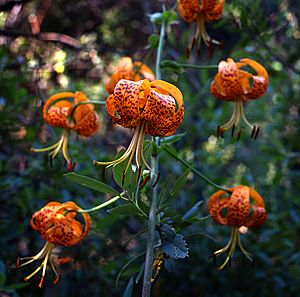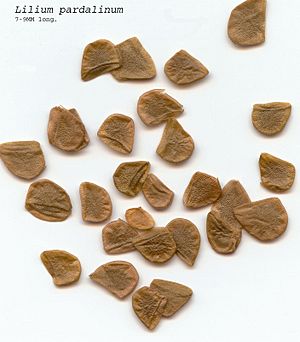Leopard lily facts for kids
Quick facts for kids Leopard lily |
|
|---|---|
 |
|
| Conservation status | |
|
Not evaluated (IUCN 2.3)
|
|
| Scientific classification | |
| Kingdom: | |
| (unranked): | |
| (unranked): | |
| Order: | |
| Family: | |
| Genus: | |
| Species: |
L. pardalinum
|
| Binomial name | |
| Lilium pardalinum Kellogg
|
|
| Synonyms | |
|
Synonymy
Lilium roezlii Regel
Lilium harrisianum Beane & Vollmer Lilium pitkinense Beane & Vollmer (syn of subsp pitkinense) Lilium shastense (Eastw.) Beane (syn of subsp shastense) Lilium nevadense Eastw. (syn of subsp shastense) Lilium vollmeri (Eastw.) Skinner (syn of subsp vollmeri) Lilium wigginsii Beane & Vollmer (syn of subsp wigginsii) |
|

The leopard lily (scientific name: Lilium pardalinum) is a beautiful flowering plant. It's also known as the panther lily. This plant grows from a bulb and comes back year after year, making it a perennial. It belongs to the lily family. You can find it growing naturally in Oregon, California, and Baja California. It especially likes damp places, like those found in the California chaparral and woodlands and the Sierra Nevada mountains.
Contents
About the Leopard Lily
The leopard lily usually grows to be about 2 meters (6.5 feet) tall. The tallest and strongest plants can even reach up to 2.5 meters (8 feet)! Its bulbs are small, and many of them often grow close together on a special underground stem called a rhizome.
What its Flowers Look Like
The flowers of the leopard lily are shaped like a "Turk's-cap," which means their petals curve backward. They are a bright red-orange color and have many brown spots. These spots make them look a bit like a leopard's fur, which is how the plant got its name! Leopard lilies usually bloom in July.
Different Kinds of Leopard Lilies
There are several different types, or subspecies, of the leopard lily. Each subspecies is a slightly different version of the plant that grows in a specific area.
- Lilium pardalinum subsp. pardalinum -- This is the main leopard lily found in southern California and Baja California.
- Lilium pardalinum subsp. pitkinense -- This one is called the Pitkin Marsh lily and grows in northwestern California.
- Lilium pardalinum subsp. shastense -- Known as the Shasta lily, it's found in Oregon and northern California.
- Lilium pardalinum subsp. vollmeri -- This is Vollmer's lily, growing in southwestern Oregon and northwestern California.
- Lilium pardalinum subsp. wigginsii -- Called Wiggins' lily, it's also found in southwestern Oregon and northwestern California.
One of these subspecies, the Pitkin Marsh lily, is considered an endangered species by the government. This means it's very rare and needs special protection to keep it from disappearing.
Growing Leopard Lilies
Many special plant nurseries grow Lilium pardalinum. People buy them as ornamental plants to make their gardens look beautiful. They are great for native plant gardens and for attracting wildlife. These tall, colorful lilies also add a lot of beauty to flower beds and are sometimes used as cut flowers. The leopard lily has even won an Award of Garden Merit from the Royal Horticultural Society, which is a big award for garden plants!
See also
 In Spanish: Lilium pardalinum para niños
In Spanish: Lilium pardalinum para niños

